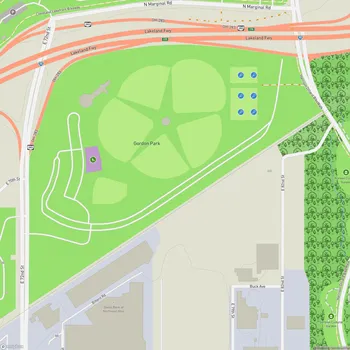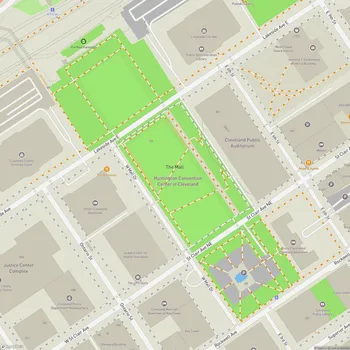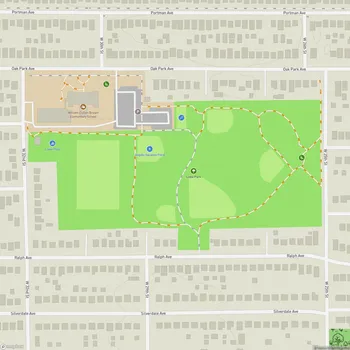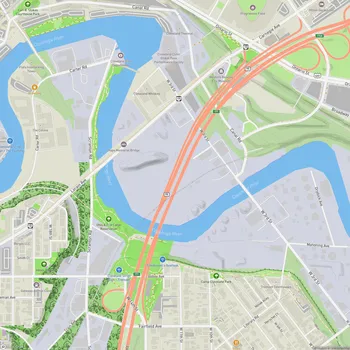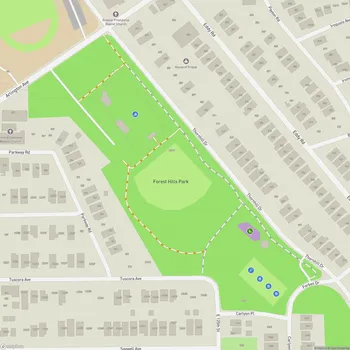Forest Hill Park
Interactive Park Map
About Forest Hill Park
Historic Background
Forest Hill Park spans 235 acres across the border of East Cleveland and Cleveland Heights, Ohio, carrying a rich legacy as part of John D. Rockefeller's former summer estate. In 1938, John D. Rockefeller Jr. gifted the land to both cities with one simple condition - that it remain a space for recreation and enjoyment for generations to come.
Natural Features
The park's landscape offers a little bit of everything - from two dramatic ravines to the winding Dugway Brook watershed. You'll find yourself wandering through dense forests one moment and open meadows the next, with recreational areas thoughtfully integrated throughout.
What makes this urban oasis special is how much of its natural character has been preserved. The old-growth forests showcase magnificent sugar maple, beech, oak, and chestnut trees. Some of these gentle giants are over 200 years old and were honored as "Moses Cleaveland Trees" back in 1946 during Cleveland's 150th birthday celebration.
The walking and hiking trails weaving through the woods provide perfect escapes from city life, with particularly stunning views when the trees burst into bloom. Parts of the trails follow a peaceful stream, however you might notice some trail markings could use a refresh and certain paths might be a bit rugged in spots.
Design and Development
Landscape architect A.D. Taylor crafted the park's thoughtful design, with much of the actual work completed by the Works Progress Administration during the late 1930s and early 1940s. Taylor's vision preserved large sections of woodland while transforming the former golf course into what's now known as the "Great Meadow."
Many of the walking paths follow Rockefeller's original trails, creating an interesting mix where some areas feel meticulously maintained while others have a wilder, more untamed character that some visitors describe as having a "post-apocalyptic vibe."
Distinctive Attractions
The park's man-made lagoon stretches over five acres and represents home to a variety of wildlife - fish, turtles, ducks, geese, and seasonal waterfowl all make appearances. Complementing this peaceful water feature is a charming stone boathouse built in 1940 and a natural-looking cascade spillway.
Another architectural highlight is the pedestrian bridge spanning Forest Hills Boulevard. Designed by engineer Wilbur Watson and architect Frank Walker in 1940, it connects different sections of the park with both function and style.
Recreational Facilities
For those looking to get active, Forest Hill offers several options. The Cleveland Heights side boasts baseball and softball fields that local players consider some of the best in area leagues. You'll also find tennis courts that double as pickleball courts, basketball courts, and a playground for the little ones.
Across the park, pavilions with picnic tables offer perfect spots for family gatherings or community events. There are also designated grilling areas if you're in the mood for an outdoor feast.
Community Use
Forest Hill Park is a well-used community space. On any given day, you'll see locals walking their dogs, runners on the trails, families picnicking, or people simply sitting quietly with nature. The park hosts various community events and sports leagues, including Challenger Baseball for participants with special needs.
Many residents have deep connections to this green space, having visited since childhood. While the quality of maintenance can vary between the Cleveland Heights and East Cleveland sections, the park remains a treasured refuge from urban life.
Recognition
Since opening to the public in 1942, Forest Hill Park has served the recreational needs of surrounding communities. Its historical significance and unique landscape earned it a spot on the National Register of Historic Places in 1998, ensuring its legacy continues to be recognized and protected.
All Features & Facilities
Active Recreation
Nature & Wildlife
Water Features & Activities
Visitor Services
Food & Gathering
Photo Gallery
ParkMagnet Score
Great Park
Park Size
Opening Hours
Weather
Top Restaurants Near Forest Hill Park
Pacific East Japanese Restaurant
0.4 miles1763 Coventry Rd, Cleveland Heights, OH 44118
A Japanese restaurant offering fresh sushi and cooked entrees alongside authentic Malaysian dishes.
High Thai'd Cafe
0.4 miles1791 Coventry Rd, Cleveland Heights, OH 44118
Casual Thai restaurant offering flavorful curries, noodles, and traditional dishes at affordable prices.
Pho and Rice
0.4 miles1780 Coventry Rd, Cleveland Heights, OH 44118
Cozy Pan-Asian eatery serving authentic Vietnamese pho and Thai specialties in a charming, intimate atmosphere.
